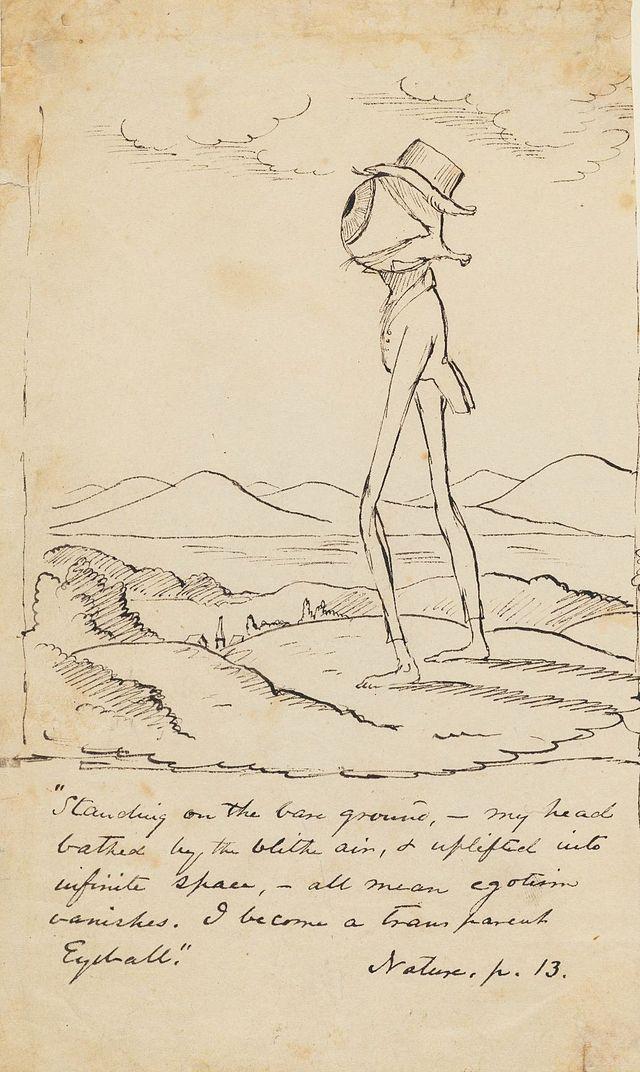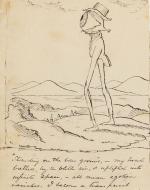Created by Katie Wagner on Mon, 03/18/2024 - 13:14
Description:
As a transcendentalist, Ralph Waldo Emerson believed that rather than glorifying the materialistic aspects of life, we should value the natural beauty of the earth and its wonders (History.com). Throughout his well-known writing of Nature, he discusses how humans naturally work to gain wealth but end up too old to enjoy their earnings by the time they have finished working. With his personal epitomes, Emerson introduces how living a simple lifestyle is more fulfilling than a high-class status. Transcendentalist writer, Ralph Waldo Emerson created the transparent eyeball shown above, in his iconic writing of "Nature", published in late 1836. The idea of the “transparent eyeball” was created as a metaphoric way of explaining how humans should be viewing the world around them. One of Emerson’s most famous quotes is directly about his relationship with this eyeball. “Standing on the bare ground,—my head bathed by the blithe air, and uplifted into infinite space,—all mean egotism vanishes. I become a transparent eye-ball. I am nothing. I see all. The currents of the Universal Being circulate through me; I am part or particle of God.” – Ralph Waldo Emerson (Emerson). Although the transcendentalist movement was a fast-growing advocacy for the unity of people, it was commonly argued that those who support this movement were “against the church”. At this time Unitarianism was the main denomination of Christianity that Americans followed. This form of Christianity claimed that Jesus was a mortal like everyone else. However, this idea is diminished by Emerson through Nature, he states that all beings on earth living or not, have a soul that is all connected by God.
Emerson’s “transparent eyeball” was brought to life by illustrator Christopher Pearse Cranch in 1837. This illustration was originally published in a local Virginia newspaper where Cranch lived, but quickly spread across the United States and landed in the hands of Emerson himself. The American people grew more curious about Emerson’s writing of Nature with the publication of this drawing, launching both Cranch and Emerson’s careers.
Works Cited
Emerson, Ralph Waldo. “Nature.” Cove Studio :: Sign In, 2006, studio.covecollective.org/anthologies/eng-235-survey-of-american-literature-sp24/documents/nature.
History.com editors. “Transcendentalism - Definition, Meaning & Beliefs.” History.Com, A&E Television Networks, 15 Nov. 2017, www.history.com/topics/19th-century/transcendentalism.
Sylvestre, Alan, et al. “Eng 230: Introduction to Environmental Literature.” ENG 230 Introduction to Environmental Literature, 13 Oct. 2012, blogs.uoregon.edu/environmentalliterature230/2012/10/13/the-transparent-eye-ball-depicting-wilderness-and-innocence/.
“Transparent Eyeball.” Wikipedia, Wikimedia Foundation, 4 Nov. 2023, en.wikipedia.org/wiki/Transparent_eyeball#/media/File:Houghton_MS_Am_1506_(4)_-_Cranch.jpg.
Copyright:
Associated Place(s)
Part of Group:
Artist:
- Christopher Pearse Cranch


